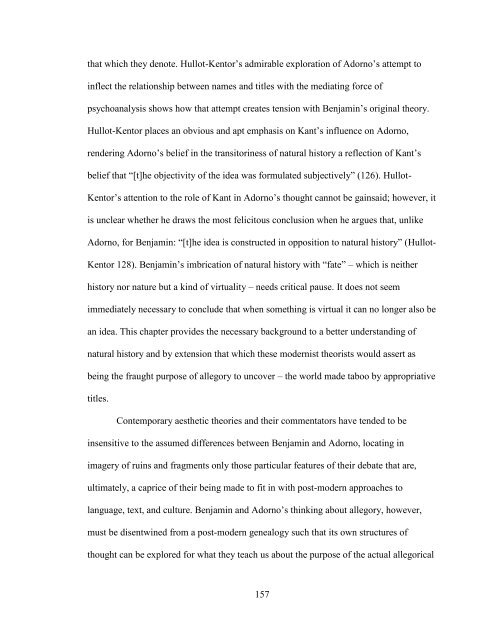TABOO: THE ACTUAL MODERNIST AESTHETIC, MADE REAL A ...
TABOO: THE ACTUAL MODERNIST AESTHETIC, MADE REAL A ...
TABOO: THE ACTUAL MODERNIST AESTHETIC, MADE REAL A ...
You also want an ePaper? Increase the reach of your titles
YUMPU automatically turns print PDFs into web optimized ePapers that Google loves.
that which they denote. Hullot-Kentor‟s admirable exploration of Adorno‟s attempt to<br />
inflect the relationship between names and titles with the mediating force of<br />
psychoanalysis shows how that attempt creates tension with Benjamin‟s original theory.<br />
Hullot-Kentor places an obvious and apt emphasis on Kant‟s influence on Adorno,<br />
rendering Adorno‟s belief in the transitoriness of natural history a reflection of Kant‟s<br />
belief that “[t]he objectivity of the idea was formulated subjectively” (126). Hullot-<br />
Kentor‟s attention to the role of Kant in Adorno‟s thought cannot be gainsaid; however, it<br />
is unclear whether he draws the most felicitous conclusion when he argues that, unlike<br />
Adorno, for Benjamin: “[t]he idea is constructed in opposition to natural history” (Hullot-<br />
Kentor 128). Benjamin‟s imbrication of natural history with “fate” – which is neither<br />
history nor nature but a kind of virtuality – needs critical pause. It does not seem<br />
immediately necessary to conclude that when something is virtual it can no longer also be<br />
an idea. This chapter provides the necessary background to a better understanding of<br />
natural history and by extension that which these modernist theorists would assert as<br />
being the fraught purpose of allegory to uncover – the world made taboo by appropriative<br />
titles.<br />
Contemporary aesthetic theories and their commentators have tended to be<br />
insensitive to the assumed differences between Benjamin and Adorno, locating in<br />
imagery of ruins and fragments only those particular features of their debate that are,<br />
ultimately, a caprice of their being made to fit in with post-modern approaches to<br />
language, text, and culture. Benjamin and Adorno‟s thinking about allegory, however,<br />
must be disentwined from a post-modern genealogy such that its own structures of<br />
thought can be explored for what they teach us about the purpose of the actual allegorical<br />
157
















